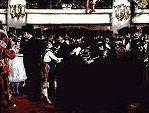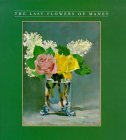
Feature Archive |
March, 2001
Édouard Manet:
Public Spaces, Private Dreams
| By Joseph Phelan |

Studies of a Young Painter in Paris
It seems as if each one of the great 19th century French painters was initially forbidden by his respectable parents to entertain ambitions of being an artist but won them over, or wore them down, by failing to succeed at any of the respectable professions they endorsed.
Manet's parents (well-educated and distinguished middle class Parisians - his father a high official in the Ministry of Justice, his mother the daughter of a diplomat) were no different. But they finally gave their consent to their son's vocation if he would study with a respectable art teacher. He choose that darling of the Salon, Thomas Couture, working under him for six years.
Couture was not a bad choice given his eclecticism, ambition, vigor and technical virtuosity. His salon masterpiece, The Romans in the Period of their Decadence, owes a painterly debt to Veronese and Tiepolo. Yet there is neither reckless paganism nor severe moralism here. This is one dull, lewd orgy. A machine, as the French say, but lacking wit, irony and the bite which true decadence always has.
Manet always sought to be accepted by the Salon and refused to exhibit with his Impressionist friends. Yet he was one of those painters who are incapable of working the way his teacher, much less the academy, wanted. While Couture would have certainly encouraged his pupils to make copies of paintings in the Louvre, the rules and the requirements of the French Academy were very nearly the opposite of what one might learn on ones own in that great museum.
There was first of all the hierarchy of genres, with History Paintings and Allegory at the top and Still Life and Landscape at the bottom. Moreover, the artist was expected to idealize the figures he painted. Manet like so many others acquired his real education by laboriously copying Titian, Tintoretto, Rembrandt, Velázquez and Goya. When he payed a visit to The elderly Delacroix in his studio, the Romantic master encouraged him to study Rubens - the great alternative to Poussin in French painting. (For the result, see Manet's 1863 painting Fishing at the Met, where he and his wife replace Rubens and his wife.)
Zola, Baudelaire and the Philosopher
After touring the museums of Europe, Manet found himself befriended by the two most advanced Parisian writers of the time, the novelist and social critic Émile Zola, and the poet and art critic Charles Baudelaire. In one of his first works under their influence he painted The Absinthe Drinker/The Philosopher (1859), which was promptly rejected by the Salon both for its choice of low life subject and its inappropriate suggestion that a street drunk and a philosopher have anything in common.
Needless to say, the members of the Academy had not caught the allusion to Socrates, whose seminar room was the streets of Athens and who lived on the surplus of his very wealthy friends, And above all, there is Plato's Symposium, perhaps the greatest of the dialogues, wherein drinking and speechmaking leads to philosophizing about the most private and profound of all matters, love... But this kind of high-spirited joke at the expense of the rules and rigidity of the Academy was the essence of the young Manet's elegant and unconventional vision.
Salon Shockers
In the next few years, Manet produced two works involving contemporary female nudes with which his name will forever be identified: The Picnic on the Grass (Le Déjeuner sur l'herbe) (1863) and Olympia (1865).
The Picnic on the Grass Allposters.com CGFA High Res Image |
Nudes were a respected subject for the academy as long as they were idealized. Both of Manet's works were based on Renaissance compositions. Picnic combines some river gods from a lost Raphael design of The Judgment of Paris (known from Marcantonio Raimondi's engraving based on the work), combined with the three seated figures from the Giorgione-Titian Concert Champêtre. Olympia updates Titian's Venus of Urbino with a pert courtesan replacing the less voluptuous belle of Titian, and sets it in a contemporary Paris brothel complete with very black maid and black cat. Here we see him taking his figures from the Renaissance masters, but rather than idealizing them he paints people he knew. Why Manet felt the need to refer to such complex High Renaissance templates when painting his contemporary Paris and its habitues has never been satisfactorily explained. |
Discovery of the Public Space
|
Manet did paint a few notable history paintings - most notably, four versions of The Execution of Emperor Maximilian of Mexico [see table at right], one of the most appalling events of French foreign policy. But this was not to be his way. Manet followed these works with much less controversial, but perhaps far more revolutionary ones. I call them his public space paintings for lack of a better term. |
|
| Music at the Tuileries Garden >  Allposters.com National Gallery, London |
The public spaces came about as a result of the new Paris being built by Baron Haussmann. His plan was to rid the capital of its intricate web of tiny streets and replace them with broad, clean avenues. Haussmann's plan to link the great train stations with the wide avenues coincided with a changing view of the city. The new bourgeois class wanted to live, work and play in the center of the city, to enjoy the privileges of theaters, museums, libraries and department stores. Haussmann gave them what they wanted. |
|
The Old Musician, Music at the Tuileries Garden, The Railway (Gare Saint-Lazare), Masked Ball at the Opera, Racetrack at Longchamp, The Balcony, The Departure of the Folkestone Boat and The Funeral (of Baudelaire) are the prime examples of this new genre of painting. As large as Salon history paintings but with contemporary Paris as their subject, these works depicted the new class or, in the case of The Old Musician, those who had been disinherited by urban renewal. |
Masked Ball at the Opera >  Allposters.com Detail images from the National Gallery of Art |
The Funeral (of Baudelaire) is the crucial painting here. It is the only time the usually tightly-controlled Manet gave his emotions full expression. Painting like a Spanish master, he expresses his bereavement in every brushstroke.
Bar at the Folies Bergère Allposters.com CGFA High Res Image |
Almost all of these paintings present the viewer with blank or dreamy or bored portraits of Parisians. This line of painting culminated with that endlessly enigmatic work which concluded Manet's public career, The Bar at the Folies Bergère Here, Manet has painted what appears to be a private reverie of the barmaid at the Folies. I say appears to be, because no two critics or art historians seem to agree on exactly what is going on between the barmaid and the man in the mirror. |
Master of the Still Life
I want to conclude this piece with at least a brief mention of the Manet still life exhibit, which is currently at the Walters Art Gallery in Baltimore (its one and only North American stop). I saw it last fall in Paris at the Musée d'Orsay.
The still life is the touchstone of the painter, Manet observed. Throughout his short career, Manet painted a large number of still lifes, and almost 80 are to be seen in this exhibit.
Sixteen of the most exquisite works were painted in his last two years, when he could only work for short periods on small works because of his weakened condition. Each painting consists of one or several of his favorite flowers (roses, lilacs, tulips) in full bloom in a wine glass or vase. As in The Funeral but without the cosmic gloom, Manet's expressive handling of the paint buoys us up when we are faced with nature's sublime indifference to our fate.
 Unfortunately, neither the Musée d'Orsay nor the Walters provide an online exhibit for all those who cannot see it in person. All is not lost - you can still find the best book on these paintings, The Last Flowers of Manet [right] by Robert Gordon and Andrew Forge.
Unfortunately, neither the Musée d'Orsay nor the Walters provide an online exhibit for all those who cannot see it in person. All is not lost - you can still find the best book on these paintings, The Last Flowers of Manet [right] by Robert Gordon and Andrew Forge.It's worth noting that many of the paintings in the exhibit are owned by museums which do have extensive online exhibits of Manet's work. I would especially recommend the online exhibits at the National Gallery of Art and the Metropolitan Museum of Art, both of which provide high definition images of paintings from all of the categories I have discussed.
I have not had time to talk about the other genres that Manet explored - the portraits of family and friends, the landscapes, the wonderful one-of-a-kind pieces like The Reading and Woman Before a Mirror.
If true elegance is defined by the elimination of unwarranted detail and the ability to penetrate into the essence of things, Manet's best paintings are among the most elegant ones we have. Let us leave the last word to Manet:
There is no doubt about it, we have in France a core of honesty that always leads us back to truth, in spite of the feats of the acrobats. Look at the Le Nain brothers, Watteau, Chardin, David himself. What a feeling for truth.
This article is copyright 2001 by Joseph Phelan. Please do not republish any portion of this article without written permission.
Joseph Phelan can be contacted at joe.phelan@verizon.net
Past Articles
February, 2001
Henry Moore and the British Museum: The Great Conversation, by Joseph Phelan
December, 2000
Advent Calendar 2000, narrated by Joseph Phelan
November, 2000
Article: Notorious Portraits, Part II, by John Malyon
October, 2000
Article: Notorious Portraits, Part I, by John Malyon
Article: The Other Michelangelo, by Joseph Phelan
September, 2000
Article: The Art of Drawing, by Joseph Phelan
August, 2000
Article: Poussin and the Heroic Landscape, by Joseph Phelan
July, 2000
Article: Great Art Museums Online, by Joseph Phelan
June, 2000
Article: Venetian Painting and the Rise of Landscape, by Joseph Phelan
May, 2000
Article: Forbidden Visions: Mythology in Art, by Joseph Phelan
April, 2000
Article: Themes in Art: The Passion of Christ, by Joseph Phelan
Web site review: Christus Rex
March, 2000
Web site review: National Gallery of Art, Washington, D.C., by Joseph Phelan
Online exhibit review: Inuit Art: The World Around Me, by John Malyon
February, 2000/Poll: Who is Producing the Most Interesting Art Today? (Results)
January, 2000/Poll: Who is Producing the Most Interesting Art Today? (Part II)
December, 1999/Poll: Who is Producing the Most Interesting Art Today? (Part I)
November, 1999/The Louvre Museum
Web site review: The Louvre
October, 1999/Impressionism
Web site review: North Carolina Museum of Art
September, 1999/Optical Art
Web site review: The Butler Institute of American Art
August, 1999/Animals in Art
Web site review: National Museum of Wildlife Art
Online exhibit review: PBS: American Visions
July, 1999/Surrealism
June, 1999/Sculpture
Web site review: Carol Gerten's Fine Art
Online exhibit review: Michael Lucero: Sculpture 1976-1995
May, 1999/Women in the Arts
Web site review: National Museum of Women in the Arts
Online exhibit review: Jenny Holzer: Please Change Beliefs
April, 1999/The Golden Age of Illustration
Web site review: Fine Arts Museums Of San Francisco
Online exhibit review: Treasure Island and Robinson Crusoe online
March, 1999/Vincent van Gogh
Web site review: Van Gogh Museum, Amsterdam
Web site review: The Vincent van Gogh Information Gallery
February, 1999/Great Art
Web site review: The State Hermitage Museum, St. Petersburg, Russia
Online exhibit review: John Singleton Copley: Watson and the Shark